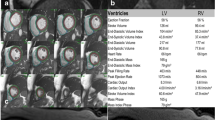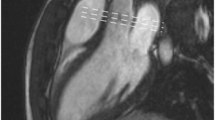Opinion statement
Echocardiography remains the cornerstone of noninvasive valvular heart disease evaluation. There are instances where MRI can be of use. Aside from the obvious advantage where limited acoustic windows are present, cardiac magnetic resonance (CMR) allows for imaging in any desired plane, and advantage can be taken of the ability to align with any regurgitant or stenotic flow jet. The high spatial resolution and contrast allow for accurate detail of valvular anatomy, but it must be remembered that the images represent a composite of eight to 12 heart cycles. For visualizing multiple valvular abnormalities simultaneously, cardiac MRI has a distinct advantage. Finally, a CMR valvular examination can be combined with accurate assessments of left and right ventricular function, myocardial stress perfusion imaging, and detailed viability determinations in a single examination. This provides a comprehensive presurgical evaluation of cardiac physiology.
Similar content being viewed by others
References and Recommended Reading
Sondergaard L, Stahlberg F, Thomsen C: Magnetic resonance imaging of valvular heart disease. J Magn Reson Imaging 1999, 10:627–638.
Didier D, Ratib O, Beghetti M, et al.: Morphologic and functional evaluation of congenital heart disease by magnetic resonance imaging. J Magn Reson Imaging 1999, 10:639–655.
Pennell DJ, Sechtem UP, Higgins CB, et al.: Clinical indications for cardiovascular magnetic resonance (CMR): Consensus Panel Report. Eur Heart J 2004, 25:1940–1965. This is an important document that summarizes indications for cardiac MRI for all disease states.
Bellenger NG, Davies LC, Francis JM, et al.: Reduction in sample size for studies of remodeling in heart failure by the use of cardiovascular magnetic resonance. J Cardiovasc Magn Reson 2000, 2:271–278.
Hundley WG, Li HF, Willard JE, et al.: Magnetic resonance imaging assessment of the severity of mitral regurgitation. Comparison with invasive techniques. Circulation 1995, 92:1151–1158.
Nayler GL, Firmin DN, Longmore DB: Blood flow imaging by cine magnetic resonance. J Comput Assist Tomogr 1986, 10:715–722.
Caruthers SD, Lin SJ, Brown P, et al.: Practical value of cardiac magnetic resonance imaging for clinical quantification of aortic stenosis: comparison with echocardiography. Circulation 2003, 108:2236–2243. This study examines the accuracy of cardiac MRI VENC sequences for aortic stenosis severity with comparison to state-of the-art echocardiography.
Wyttenbach R, Bremerich J, Saeed M, et al.: Integrated MR imaging approach to valvular heart disease. Cardiol Clin 1998, 16:277–294.
Friedrich MG, Schulz-Menger J, Poetsch T, et al.: Quantification of valvular aortic stenosis by magnetic resonance imaging. Am Heart J 2002, 144:329–334.
John AS, Dill T, Brandt RR, et al.: Magnetic resonance to assess the aortic valve area in aortic stenosis: how does it compare to current diagnostic standards? J Am Coll Cardiol 2003, 42:519–526. A comparison of planimetry of the aortic valve by MRI sequences with left heart catheterization and transesophageal echocardiography for aortic valve area.
Kupfahl C, Honold M, Meinhardt G, et al.: Evaluation of aortic stenosis by cardiovascular magnetic resonance imaging: comparison with established routine clinical techniques. Heart 2004, 90:893–901. A comparison of aortic valve planimetry by MRI versus echocardiography using the continuity equation.
Eichenberger AC, Jenni R, von Schulthess GK: Aortic valve pressure gradients in patients with aortic stenosis: quantification with velocity-encoded cine MR imaging. AJR Am J Roentgenol 1993, 160:971–977.
Sondergaard L, Hildebrandt P, Lindvig K, et al.: Valve area and cardiac output in aortic stenosis: quantification by magnetic resonance velocity mapping. Am Heart J 1993, 12:1156–1164.
Kozerke S, Schwitter J, Pedersen EM, et al.: Aortic and mitral regurgitation: quantification using moving slice velocity mapping. J Magn Reson Imaging 2001, 14:106–112.
Pflugfelder PW, Lanzberg JS, Cassidy MM, et al.: Comparison of cine MR imaging with Doppler echocardiography for the evaluation of aortic regurgitation. AJR Am J Roentgenol 1989, 152:729–735.
Olearchyk AS: Congenital bicuspid aortic valve and an aneurysm of the ascending aorta. J Card Surg 2004, 19:462–463. This surgical series demonstrates a 16% prevalence of ascending aortic aneurysms in the presence of bicuspid aortic valves, underscoring the importance of complete visualization of the thoracic aorta in such patients.
Chatzimavroudis GP, Walker PG, Oshinski JN, et al.: The importance of slice location on the accuracy of aortic regurgitation measurements with magnetic resonance phase velocity mapping. Ann Biomed Eng 1997, 25:644–652.
Charzimavroudis GP, Oshinski JN, Franch RH, et al.: Quantification of the aortic regurgitant volume with magnetic resonance phase velocity mapping: a clinical investigation of the importance of imaging slice location. J Heart Valve Dis 1998, 7:94–101.
Dulce MC, Mostbeck GH, O’Sullivan M, et al.: Severity of aortic regurgitation. Interstudy reproducibility of measurements with velocity-encoded cine MR imaging. Radiology 1992, 185:235–240.
Djavidani B, Debl K, Lenhart M, et al.: Planimetry of mitral valve stenosis by magnetic resonance imaging. J Am Coll Cardiol 2005, 45:2048–2053. This study demonstrated good correlation between planimetry of the mitral valve from gradient echo sequences and echocardiographic and catheter-based techniques.
Heidenreich PA, Steffens J, Fujita N, et al.: Evaluation of mitral stenosis with velocity-encoded cine magnetic resonance imaging. Am J Cardiol 1995, 75:365–369.
Lin SJ, Brown PA, Watkins MP, et al.: Quantification of stenotic mitral valve area with magnetic resonance imaging and comparison with Doppler ultrasound. J Am Coll Cardiol 2004, 44:133–137. This paper examines the correlation of mitral valve inflow patterns by phase VENC MRI and Doppler echocardiography to determine pressure half-time values.
Kon MW, Myerson SG, Noat NE, et al.: Quantification of regurgitant fraction in mitral regurgitation by cardiovascular magnetic resonance: comparison of techniques. J Heart Valve Dis 2004, 13:600–607. In this article, the reproducibility of mitral regurgitation quantitation by volume and flow techniques by MRI is compared.
Walker PG, Houlind K, Djurhuus C: Motion correction for the quantification of mitral regurgitation using the control volume method. Magn Res Med 2000, 43:726–733.
Dujardin KS, Enriquez-Sarano M, Bailey KR: Grading of mitral regurgitation by quantitative Doppler echocardiography: calibration by left ventricular angiography in routine clinical practice. Circulation 1997, 96:3409–3415.
Shellock FG: MR imaging of metallic implants and materials: a compilation of the literature. AJR Am J Roentgenol 1988, 151:811–814.
Shellock FG, Crues JV: High field-strength CMR imaging and metallic biomedical implants: an ex-vivo evaluation of deflection forces. AJR Am J Roentgenol 1988, 151:389–392.
Author information
Authors and Affiliations
Rights and permissions
About this article
Cite this article
Gentchos, G.E., Tischler, M.D. & Christian, T.F. Imaging and quantifying valvular heart disease using magnetic resonance techniques. Curr Treat Options Cardio Med 8, 453–460 (2006). https://doi.org/10.1007/s11936-006-0033-7
Issue Date:
DOI: https://doi.org/10.1007/s11936-006-0033-7




